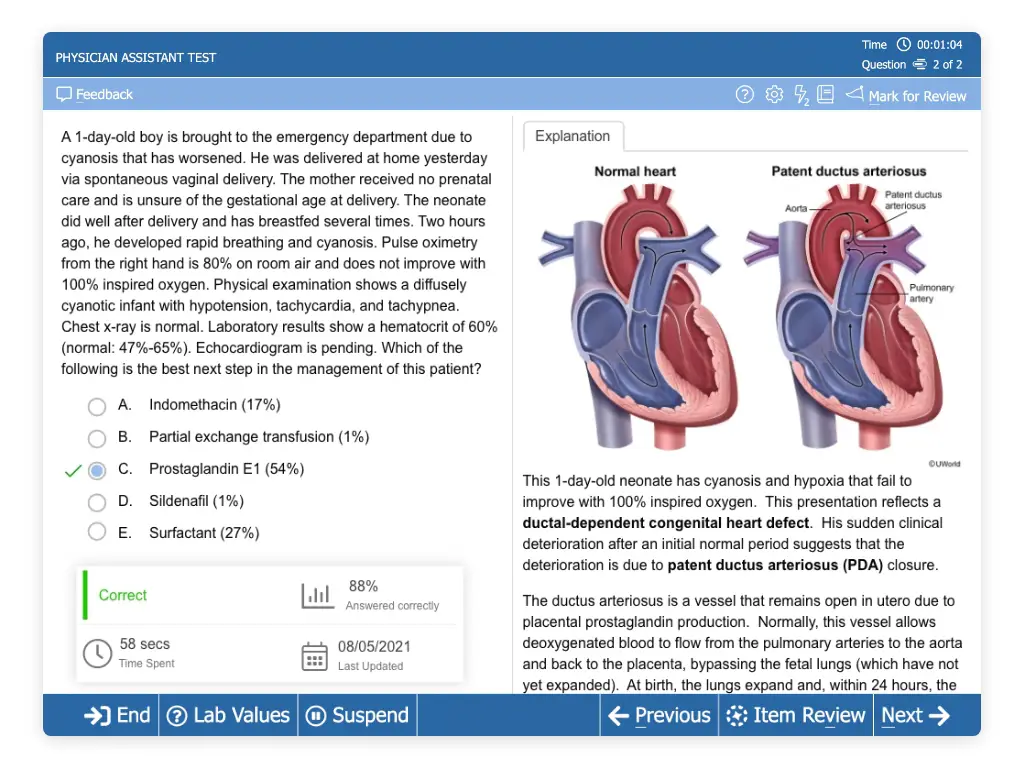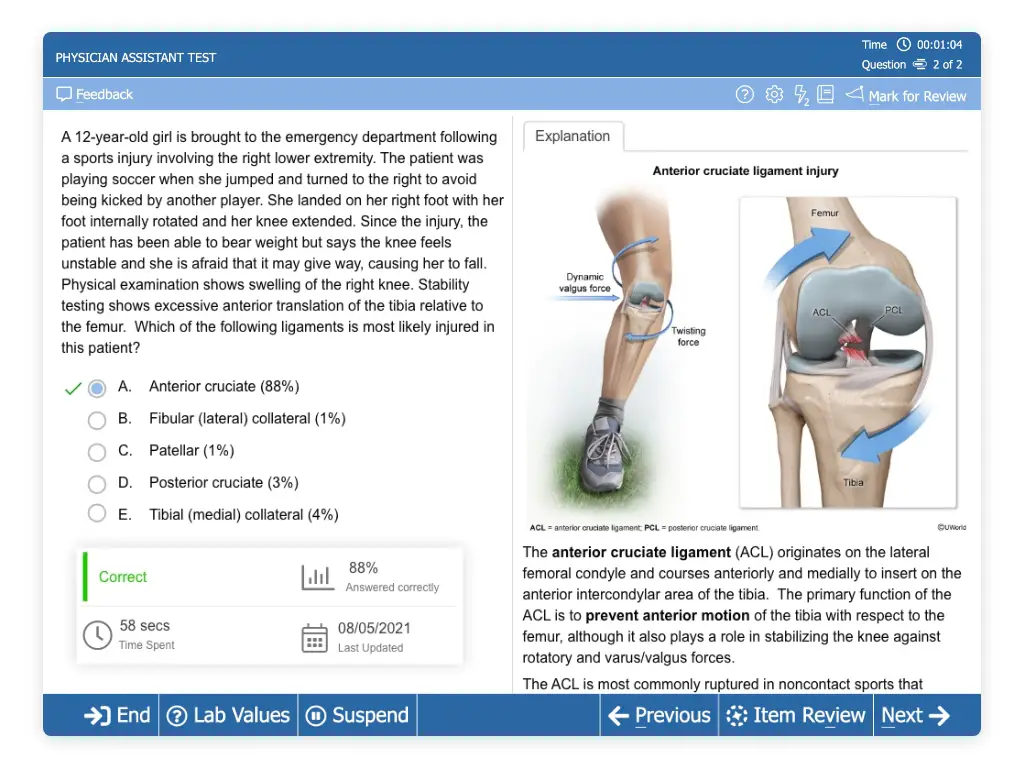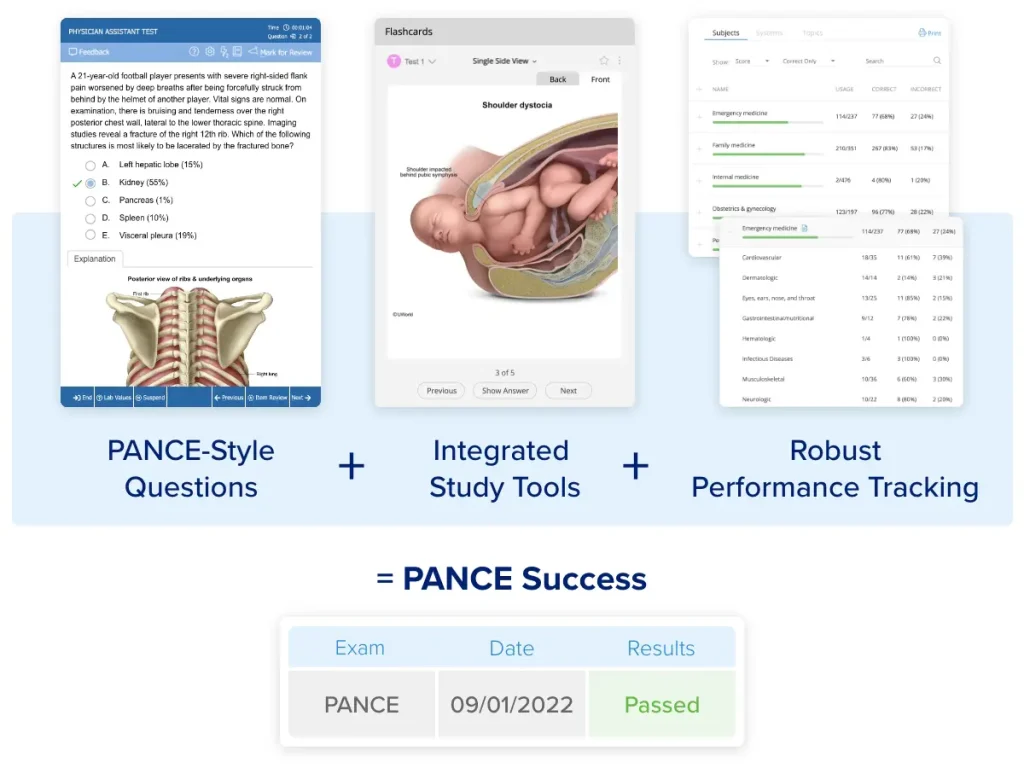About the PANCE
Exam Format and Structure
The Physician Assistant National Certifying Examination (PANCE) is a high-stakes licensure exam that candidates must pass in order to become a certified physician assistant. For PA students beginning their PANCE prep, it is recommended that they know about the exam format, develop a PANCE study guide and practice diligently with quality PANCE practice questions in order to achieve exam success. This guide discusses everything you need to know about the PANCE including eligibility, exam format and structure.
Why Take The PANCE Exam and Who Can Take It?
In 1974, the American Medical Association® (AMA®) and the National Board of Medical Examiners® (NBME®) formed the National Commission on Certification of Physician Assistants® (NCCPA®), an organization that would be responsible for the requirements for PA eligibility and setting the passing standard for initial certification and periodic recertification. The PANCE was first administered by the NCCPA in 1975.
Graduates of an accredited PA program are eligible to register for and take the PANCE. It is required to pass the PANCE in order to earn certification and begin practicing medicine as a physician assistant. Upon Passing the PANCE, PAs are granted NCCPA certification and have earned the PA-C designation.
When do you take the PANCE?
If you are a graduate of an accredited PA program, you are eligible to take the PANCE as soon as seven days after you graduate. You are eligible to take the PANCE for up to six years after your graduation. Most students take the exam shortly after graduation because the content they learned in their didactics and clinicals is still fresh in their memory.

How many times can you take the PANCE?
If you fail the PANCE, you can retake it; however, there is a limit to how many times you can attempt to pass the PANCE. You may take the PANCE up to a maximum of six times within the six years following the date of your graduation from PA school. If you haven’t passed the PANCE after six attempts, or if you don’t take the PANCE before your six-year window has ended, you will no longer be eligible to take the exam.
What Is on the PANCE Exam?
The PANCE is developed from the NCCPA’s content blueprint and tests your knowledge in two different categories:
- Knowledge of the diseases and disorders PAs encounter
- Knowledge and skills related to tasks PAs perform when treating patients
The medical categories tested and the weight each is given on the exam are as follows:
Medical Content Categories % Allocation
and Throat
System/Nutrition
(Male and Female)
Science
(Male and Female)
The task categories tested and the weight each is given on the exam are as follows:
Task Categories % Allocation
Performing Physical
Examination
Laboratory Studies
Likely Diagnosis
Patient Education, and
Preventive Measures
Therapeutics
Concepts
Medical content makes up 95% of the PANCE, and questions about professional practice make up the remaining 5% of the PANCE. Learn more about the PANCE Blueprint.
Are PANCE practice exams worth it?
Not only are PANCE practice exams worth it, they are highly recommended for exam success. Due to the high-stakes nature of the PANCE, it is important to prepare for this PA certification exam with quality PANCE practice questions. UWorld provides challenging, PANCE-style practice questions as well as in-depth answer explanations that will help you prepare for the rigors of the exam. When you sit for your exam, the practice exams you have taken will make the actual test feel like just another study session.
PANCE Exam Format and Structure
The PANCE is a five-hour exam that is broken down into five different blocks of questions — each block is made up of 60 questions and you are given 60 minutes to complete each block of questions.
You are given a total of 45 minutes for scheduled breaks in between blocks of questions during the exam. Any break time taken beyond the allowed 45 minutes will be deducted from your exam time. During your scheduled break time, you are permitted to visit your locker at the testing site and access any personal items stored there.
Personal items such as purses, bookbags, watches, cell phones, food, beverages, calculators, study materials, etc. are not permitted in the exam room; however, you can access these items during scheduled break times. Any belongings that seem suspicious may be subject to inspection.
How many questions are on the PANCE?
The PANCE consists of 300 multiple-choice questions. Due to the challenging nature of these questions and the rigor of the lengthy exam, it is important to practice with similar questions ahead of time. UWorld offers over 2,000+ challenging PANCE practice questions, in-depth explanations for every answer choice, vivid medical illustrations, flashcards with spaced repetition, and precise performance tracking. If you prepare in advance for the exam with these premium tools, you will be ready for the 300 multiple-choice questions you will encounter on exam day.
Is the PANCE hard?
The PANCE is a difficult exam. For PA students wondering “why is the PANCE so hard?” The answer is simple: the PANCE is a licensure exam that tests medical and surgical competency. The exam determines which candidates are ready to begin practicing medicine as certified PAs and which candidates are not yet ready to be licensed. Multiple competencies are tested, and there is a large volume of content tested on the exam. The added pressure of needing to pass the exam for licensure can also make the exam more stressful.
Is UWorld’s PANCE prep hard?
UWorld’s award-winning PANCE prep is written by accomplished, practicing PAs with extensive clinical experience. The PANCE practice questions you will encounter in your UWorld question bank (QBank) are at the exam level or more difficult than those you will face on your exam. It is imperative that you challenge yourself with difficult questions to prepare for the exam and clinical practice.

Fantastic thus far. Challenging questions that are often 2nd and 3rd order require more in-depth reasoning.
Very similar to actual PANCE questions. Incredibly helpful for studying to retake the exam. Much better than other resources I've used in the past.
Tips for Passing the PANCE on the First Attempt
In order to pass the PANCE on the first attempt, be sure to give yourself sufficient time before the exam to prepare properly. We recommend you prep for the exam for three to six months. Practice with PANCE-like questions and be sure to study UWorld’s explanations carefully. Take advantage of the integrated study tools that improve memory recall and facilitate content review. The PA QBank is equipped with flashcards with spaced repetition and an online notebook tool. Review your performance reports regularly to discover any weak areas and target your prep to strengthen your knowledge in those areas. Be sure to take at least one full-length practice exam in test-like conditions to prepare you for the length of the exam.
Frequently Asked Questions
What do I take to the testing center when taking the PANCE?
You will need to bring two forms of valid and current identification to your testing site. One form of identification must contain your printed name, signature, and a permanently affixed photograph. The second form of identification must contain your printed name and signature.
Any personal items you bring to the exam must be kept in your assigned locker at the testing site. You will be permitted to access personal items only during your scheduled breaks during the PANCE exam.




